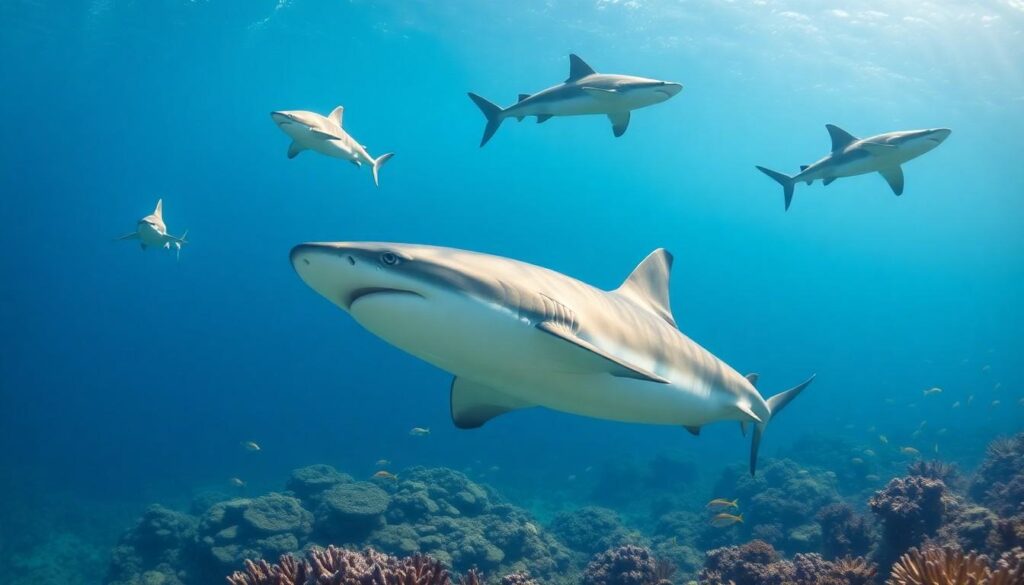Sharks have long fascinated us with their sleek bodies and mysterious behaviors. But have you ever wondered just how many species of these incredible creatures swim in our oceans? The answer might surprise you. Current estimates suggest there are over 500 recognized species of sharks, ranging from the tiny dwarf lanternshark to the massive whale shark.
Each species plays a vital role in maintaining the balance of marine ecosystems. Understanding the diversity of sharks not only deepens your appreciation for these magnificent animals but also highlights the importance of their conservation. So let’s dive into the world of sharks and explore the fascinating variety that exists beneath the waves.
Overview of Shark Species
Sharks comprise over 500 recognized species, each differing in size, habitat, and behavior. The diversity of sharks is critical for the health of marine ecosystems. Below is a breakdown of the major categories of shark species based on their characteristics:
| Category | Examples | Characteristics |
|---|---|---|
| Major Species | Great white shark, Hammerhead shark | Apex predators, play a key role in controlling prey populations. |
| Deep-Sea Sharks | Goblin shark, Frilled shark | Adapted to abyssal environments, often have unique adaptations for deep locations. |
| Shortfin Mako | Shortfin mako, Longfin mako | Known for their speed, these sharks can swim at speeds of up to 45 mph. |
| Basking Sharks | Basking shark, Whale shark | Filter feeders that consume large quantities of plankton. |
| Small Sharks | Dwarf lanternshark, Cookiecutter shark | Generally less than 4 feet in length, these species exhibit fascinating behaviors. |
Sharks inhabit various marine environments, from shallow coastal waters to the deep ocean. They range in size from the dwarf lanternshark, measuring about 8 inches in length, to the whale shark, which can exceed 40 feet.
Sharks are essential to maintaining marine biodiversity. Their feeding patterns influence the populations of other species and contribute to the overall balance in ocean habitats. Conservation efforts for all 500-plus species are vital, as many face threats from overfishing, habitat loss, and climate change.
The following table illustrates a few key statistics related to shark species:
| Statistic | Value |
|---|---|
| Total Number of Species | Over 500 |
| Largest Species | Whale shark (up to 40 feet) |
| Smallest Species | Dwarf lanternshark (8 inches) |
| Average Lifespan | 20-30 years (varies by species) |
Understanding the diversity and role of these species is crucial in promoting effective conservation strategies and appreciating their importance in the ocean’s health.
Diversity of Shark Species
Shark diversity showcases an impressive range, with over 500 recognized species, each contributing significantly to marine ecosystems. These species exhibit varied characteristics, habitats, and roles in the ocean.
Major Shark Families
Sharks belong to several major families. Key families include:
| Shark Family | Example Species | Unique Features |
|---|---|---|
| Carcharhinidae | Bull Shark, Blacktip Shark | Adaptable, found in various habitats |
| Lamnidae | Great White Shark, Shortfin Mako | Streamlined bodies, high swimmers |
| Orectolobidae | Nurse Shark, Whale Shark | Bottom-dwellers, unique feeding habits |
| Scyliorhinidae | Catshark, Spotted Dogfish | Small size, often nocturnal |
| Sphyrnidae | Hammerhead Sharks | Distinctive head shape, enhanced vision |
Notable Shark Species
Certain shark species stand out due to their size, behavior, or distinct characteristics. Notable species comprise:
| Shark Species | Size | Habitat |
|---|---|---|
| Whale Shark | Up to 40 ft | Warm ocean waters |
| Great White Shark | Up to 20 ft | Coastal waters |
| Bull Shark | Up to 11.5 ft | Rivers, estuaries |
| Dwarf Lanternshark | About 8 in | Deep waters |
| Basking Shark | Up to 33 ft | Plankton-rich waters |
Understanding these families and species enriches your appreciation of shark diversity and highlights the importance of their conservation.
The Importance of Shark Biodiversity
Shark biodiversity plays a crucial role in marine ecosystems. Each species contributes uniquely to the health and stability of ocean environments. Understanding these roles enhances conservation efforts.
Ecological Role of Sharks
Sharks serve as apex predators, regulating the populations of prey species. This regulation maintains the balance in marine ecosystems. Healthy shark populations support:
- Prey Control: Sharks influence the abundance of fish species, protecting vital habitats like coral reefs and seagrasses.
- Species Diversity: By controlling competitive species, sharks allow for greater diversity among marine life.
- Nutrient Cycling: Sharks contribute to nutrient cycling through their feeding habits and waste production, supporting lower trophic levels.
| Ecological Role | Impact |
|---|---|
| Prey Control | Maintains balance in fish populations |
| Species Diversity | Promotes a variety of marine species |
| Nutrient Cycling | Supports ecosystem productivity |
Threats to Shark Populations
- Overfishing: Unsustainable fishing practices eliminate numerous shark species, disrupting marine ecosystems.
- Habitat Loss: Coastal development and pollution reduce suitable habitats for breeding and feeding.
- Climate Change: Rising ocean temperatures alter distribution patterns and affect shark migration.
| Threat | Description |
|---|---|
| Overfishing | Depletes shark numbers significantly |
| Habitat Loss | Diminishes breeding and feeding grounds |
| Climate Change | Affects distribution and migration patterns |
Current Classification and Research
Shark species classification involves various scientific methods that categorize these animals based on morphological and genetic traits. Understanding these classifications helps clarify the relationships among species and informs conservation efforts.
Scientific Classification Methods
- Morphological Analysis: Utilizes physical traits such as body shape and fin structure.
- Molecular Genetics: Analyzes DNA sequences to identify evolutionary relationships.
- Ecological Traits: Examines habitat preferences and behavioral patterns to classify species.
- Taxonomic Hierarchy: Categorizes sharks into families, genera, and species for organized study.
| Classification Method | Description |
|---|---|
| Morphological Analysis | Focuses on observable physical characteristics |
| Molecular Genetics | Uses genetic data for classification |
| Ecological Traits | Considers habitat and behavior |
| Taxonomic Hierarchy | Organizes species into categories |
Recent Discoveries in Shark Species
Recent research highlights the ongoing discovery of new shark species and the importance of genetic studies. Innovative techniques reveal hidden diversity within known species. For instance, the Ninja Lanternshark was identified in 2015, showcasing the need for continuous exploration. Studies also indicate several populations previously thought extinct continue to thrive.
| Notable Recent Discoveries | Year Identified | Significance |
|---|---|---|
| Ninja Lanternshark | 2015 | Increases understanding of biodiversity |
| New Hammerhead Species | 2020 | Highlights classification complexities |
New technologies assist in tracking shark movements, revealing migration patterns. Such discoveries emphasize the necessity of focused conservation efforts and provide critical insights into marine biodiversity.
Conclusion
Understanding the diversity of shark species is essential for appreciating their role in ocean ecosystems. With over 500 recognized species each contributing to marine health and stability you can see how vital these creatures are. Their unique characteristics and behaviors highlight the complexity of life beneath the waves.
As you explore the world of sharks remember that many species face serious threats. Your awareness and support for conservation efforts can make a difference. By valuing shark biodiversity you play a part in ensuring these magnificent creatures continue to thrive in our oceans for generations to come.
Frequently Asked Questions
How many species of sharks are there?
There are over 500 recognized species of sharks, ranging from the tiny dwarf lanternshark, which measures about 8 inches, to the massive whale shark, exceeding 40 feet in length.
Why are sharks important for marine ecosystems?
Sharks play a crucial role as apex predators, helping to regulate the population of other marine species. This maintains the balance of marine ecosystems, supporting biodiversity and nutrient cycling.
What are some major families of sharks?
Sharks are categorized into several major families, including Carcharhinidae (e.g., Bull Shark), Lamnidae (e.g., Great White Shark), Orectolobidae (e.g., Whale Shark), Scyliorhinidae (e.g., Catshark), and Sphyrnidae (e.g., Hammerhead Sharks).
What threats do sharks face today?
Sharks are threatened by overfishing, habitat loss, and climate change. Overfishing reduces shark populations, habitat loss affects breeding grounds, and climate change alters their distribution and migration.
How is shark biodiversity assessed?
Shark biodiversity is assessed through methods such as morphological analysis, molecular genetics, and ecological traits. These methods help clarify species relationships and guide effective conservation efforts.
What recent discoveries have been made in shark research?
Recent discoveries include the Ninja Lanternshark identified in 2015 and new species of hammerhead sharks identified in 2020, showcasing the ongoing exploration of shark diversity and classification complexities.
What technologies are used to track sharks?
New technologies, such as tagging and satellite tracking, are used to study shark migration patterns. This research is essential for understanding their behavior and informing conservation efforts.

